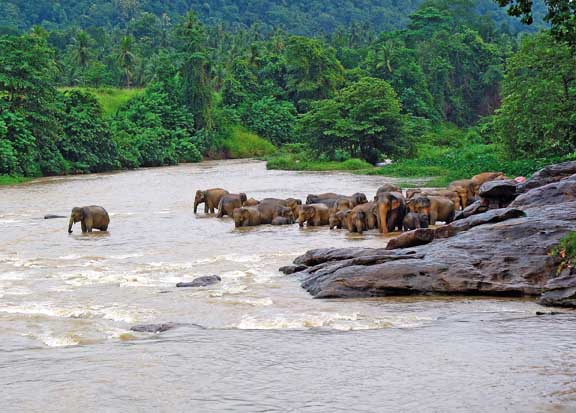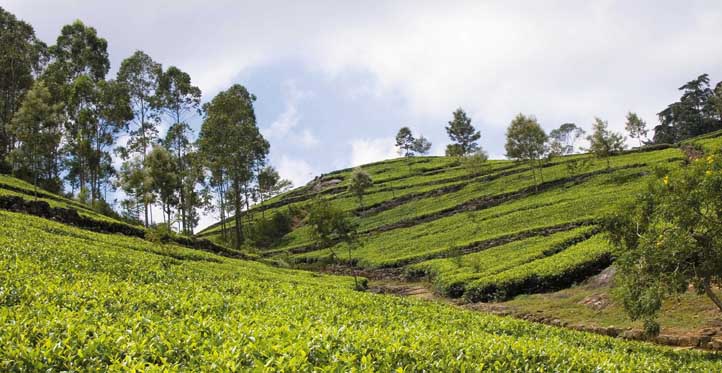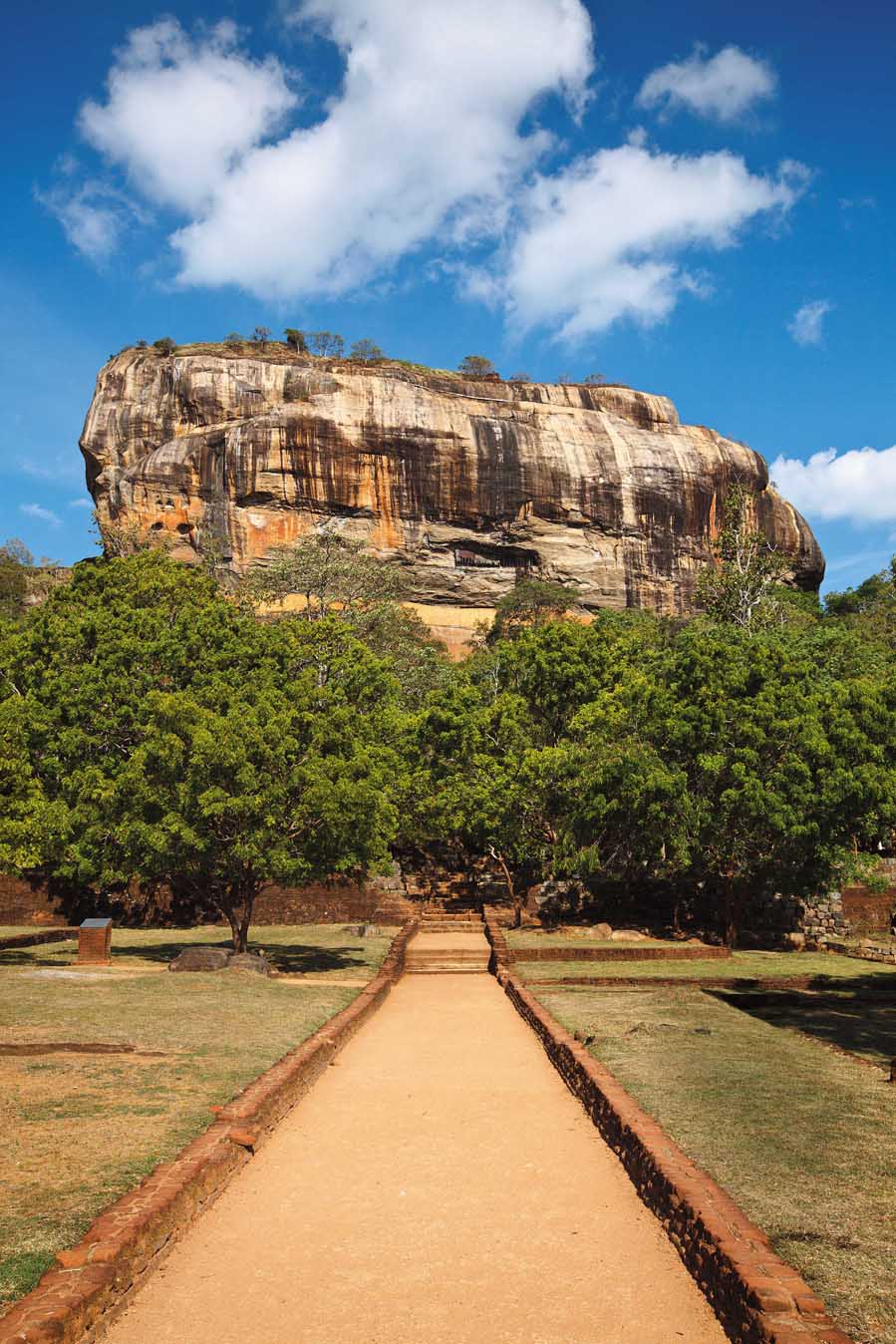

Sri Lanka
A Providential Journey
 |
It is described as paradise on earth. It is said that when God send Adam down to earth, He didn’t want the “father of humanity” to feel lonely, so the Almighty recreated this piece of haven for him.
By Marwan Asmar
Subsequently, and for Muslims, part of this strip of land became known as Adam’s Peak, a mountain top just below the city of Colombo. Our recent trip to Sri Lanka reflected a heavenly experience. As we drove through the central plains of the country, in between its hills and mounts, woods and forests, through its tiny villages, towns and cities, we received pangs of delight as we saw the terrain etched upfront as if it were a painting.
Our local tour guide Mr Jayawadana, affectionately called Jaya, told me in total we drove 731 kilometers through the country covering historical, archaeological, and nature reserves places to the east cost of Trincomalee which the Sri Lankan government wants to develop.
The mini-bus took us to a green wonderland where the eyes gazed at the beautiful, majestic, awe-inspiring places we never knew existed, nor had known about Sri Lanka; standing out as an emerald of a gem, mesmerizing me and my colleagues into an spell-bounding disbelief and reverence to the rugged, intuitive marching call of nature, as it has existed wondrously and haphazardly over the centuries.
Our first stop was at the Pinnawala Elephant Orphanage that was created in 1975 by the government to look after injured and abandoned elephants.
It was thoughtful as elephants serve part of the natural picturesque terrains. Having started with just five elephants, the Orphanage has more than 80 today. We saw them brought down by their Mahouts, those who take care of them, all the way to the river, walking judiciously but slowly, a sense of decorum and grace, through a foot-path anxiously moving to smother themselves and their trunks with the deep blue fresh water. 
We took pictures while they carried on with their swimming playfully and joyously almost performing a show to us. Just over-looking the river, was our restaurant, we sat, ate and watched in a serene atmosphere while the elephants splashed themselves and the others, congregating in pairs and groups, with the odd loners, here and there. On the other side was another green etching of a lush green panorama of coconut, banana, mango and teak trees, a tropical scenario right especially put together for the benefit of our eyes.
Jaya told us after a while these elephants became domesticated and could not live in the wild because they became attached to the people. We were within inches of them, big huge and little creatures that quickly gave me flash backs to the Tarzan films. They were taken to the river twice a day, in the mornings and afternoon, but couldn’t quite get enough of the water.
At mid-afternoon, our mini-bus departed to another beautiful setting to the secluded village of Sigiriya where I lounged in my spacious hotel chalet. I preferred to stay in, relax in the cozy room and watch a bit of television and try and fathom that day’s activities and rides across the countryside.
The Sigiriya village overwhelmed my imagination. This was an intrepid place for honeymooners, high-powered businessmen, career professionals and much more, and which we subsequently saw meandering together in pure bliss. This would be an utterly fantastic place for the humdrum intellectual, deprived of breathing air, and who certainly would be inspired and even re-educated into the art of writing and imagination.
The awesomeness and sheer audacity of the place was yet to be seen and devoured as we made our way to the massive rock fortress of Sigiriya, a huge structure in existence since the 5th century. Long designated as a World Heritage Site, our guide Raja explained you need to climb 1,200 steps to get to the top where a king once lived and wanted to protect himself from his brother having taken the throne by force back during that time.
I was determined to climb as far up as I could with numerous other tourists, including many, many local school pupils wearing white uniformed accompanied us. We decided to stop at the half-way mark, in front of you there was auspicious surroundings of greenery as far as the gaze can take you. It was majestic, colorful, beautiful and wonderful.
“Feel the fresh air, get as much of it into your lungs, as possible, it is pure, nothing like it anywhere,” Obeid added.
Although the climb proved tiring because of the down-trodden steps when there was at time problems in squaring your feet, it was a prodigious feeling of excitement to be moving downwards, an atmosphere serene, calming and pleasurable.
After lunch at the hotel we made our way to Trincomalee by the beach and sea. The area is still being redeveloped. The blue sea gives excitement that is nowhere to be found, and beyond there was what the guide explained Pigeon Island, a small but not inhabited place one can experience and get to by boat. 
I kept telling myself, even if the worst gets to the worst, people can eat from the splendor of the fruit trees on both sides of the roads, in the fields, the woods and the forests. The fruits are there for the picking, the taking and consuming.
The coconut, Jackfruit, the mango and the papaya trees, displayed themselves in full glory. The pineapple plantations as well as coffee, rubber, coco, tea and the spice trade had long become a concentric geographical circle linking the West with the East, the Indian subcontinent and Sri Lanka with the Arab Gulf region and developed many sea trade routes over the centuries.
What was amazing, and signifying the beauty of nature, is that some of these fruit trees grew together, side-by-side, increasing the dramatic effects of the foliage, shrubbery, vegetation scenery and environment and the mixture of these huge plants.
On the way to the Kandalma Heritage, at Dambulla we stopped at one of the road-type shops to buy and drink from the coconut. At 35 rupees, and holding it in your hand, it is a good deal bigger than when seen hanging high up. It looks like a huge ball in your hands.
With straws we sipped the cool, sweet taste but which you had to get used to. Afterwards the vendor sliced the coconut in two-halves, and we proceeded to eat the soft incessantly white flesh belly that was a delicious sort of assortment.
Under the hot, sticky, humid weather, the coconut drink was just what we needed, preventing thirst and keeping the throat moist.
We were struck, nay awe-inspired by what we saw next with the Heritance Kandalama standing majestically on the horizons. We had lunch there amidst the plush surroundings and the high class restaurant that served delicious top quality cuisine as recognized through its international certificates and awards.
It was a short afternoon, we met the general manager of the hotel who told us the establishment is visited by many international politicians and diplomats, including presidents, prime ministers and ministers who come here to relax. Its Royal suit is luxurious, part of a top of the range accommodation that is high tech and designed to cater for the needs of any businessmen, and ordinary people wanting to enjoy the nature of the surroundings at palatial but very easy pace. Most of these offer Jacuzzis to allow its guests to unwind while looking out of the window at the magnificent surroundings.
Many of my colleagues said this was the place, they wanted to stay, but our itinerary commanded otherwise. Our next stop was the Mahaweli Reach Hotel just outside the city of Kandy, the traditional and cultural capital of Sri Lanka.
There was a sense of excitement as we entered the hotel as each of us were showered by flowers, another traditional custom, making us feel our worth in gold.
Accommodation proved excellent, the rooms were great, bright and big but in a homely kind of way. They were attractive, a delicious bowel of fruit salad added to that fresh air of comfort. It was a relaxed atmosphere that gave one the feelings that he has been there before.
This feeling was reinforced by the excellent service in the restaurant with the waiters, men and women and quite a few in their colorful saris, giving you that congenial smile and ready to help and answer any of the questions you may throw at them.
You felt you had known these people a long, long time, even though the English was a little trying at times. Michelle de Fontane, public relations manager, graciously showed us around the hotel and explained a little bit about its history, showed us around its presidential suit and executive rooms before we plucked up courage and left to Nuwara Eliya.
Judging from my elegant room, I already made up my mind. This is definitely a place to stay and as seen by its enormous visitors that came from the Arabian Gulf, India, Europe as well as locals who made their homes in the United States.
The road to Nuwara Eliya took us back to Kandy. The previous day I brought a couple of books from there, being unable to resist bookshops. One was The Village by the Seaside by Anita Desai, another on Tales from the Arabian Nights. I was excited by the former, having heard about for such a long time. I found the bookshop while my friends milled around town to do some shopping from the plenty of good stores. Before everyone went their separate ways for the afternoon, we stopped at a major mosque in the city to perform the Friday prayer.
Kandy is striking, and replicated to what we have become used to in terms of plush scenery. On its outskirts was the Royal Botanical Gardens, a tremendous park of green architecture that kept everyone staring. The Gardens were established by the British in 1861 and included 1700 of flora and funa.
Our walk about had to be cut short because of the sudden downpour that occurs up to three or four times a day. We were drenched but it was pleasant because of the humid weather and then made our way through Peradeniya University, a huge neat campus of eight faculties that include engineering and medicine and students coming from all over the India subcontinent. I was told it was one of the 16 public universities that exist, and not to mention the private universities that were constantly coming up. 
We took photos of the Banyan tree, an extremely beautiful and mesmerizing structure which I had not seen before and then strolled on to the captivating hills and mountains of Nuwara Eliya, that beautifully nestled between high mountains that made temperatures dive, thinking you have moved to another country. We were now between the tea estates, magnificent fields of the green leaf that went into making real tea.
It was drizzling here, but it was the rains that made the lands so beautifully fertile and imaginary, so enchanting. In one Mackwood Labookellie Tea Estate, we were kindly shown the different stages of tea-making, from picking, to sorting out, fumigating, and drying to having the brew on our kitchen table.
We were told by our tea lady guide that tea production forms 30 percent of the gross national product in Sri Lanka, and there are 300 tea estates in the country.
That afternoon as well we stopped in one of the side hotels to have lunch that was situated near a great big waterfall which not only bellowed water, but let out particles of steam that added to the aura of the cascade. The Ramboda Waterfall was triumphant, it was here where one felt freedom spreading into his veins, a sense of being tremendously alive, joyous, happy, willing to forget all life’s little problems, and thinking how small man is in front of the ruggedness of nature.
All through this road, the waterfalls dazzled, some small, some large, water gushing forward forming pathways and streams down under to make the land more fertile, green, and incredibly seductive, wondering at times whether you are on another planet. This was the secret behind the green emerald as the water hammered and sprinkled mother earth with its rain drops and down-powers and the new horizons of elegance it created.
An extension of that is the Grand Hotel, a majestic edifice that spewed tradition and staidness established in the second half of the 19th century. Big lobbies, and a large dining hall, the place exhibited international and local cuisines that catered for everyone’s tastes with mouth-watering palates and gourmet delights.
Travelling Sri Lanka is a great, different, wholesome experience. It is a vibrant, eclectic and didactic journey to move your body, mind and soul into twirls and loops. It has all the mysteries and charms to unwind and say this is where I want to be and come time and again and tied and become converted to mother earth, its panache, wisdom and glory.
Colombo was concrete, resembling the industrialization of world cities. On the way to the airport, I wanted to turn right back to the elephants, Sigiriya, Kandy and Nuwara Eliya, to the waterfalls and the trees like the courageous famous writer Arthur C. Clark who died in the last few years. He came to Sri Lanka in 1955, looked at the place and simply settled, writing over 100 science fiction books in this indelible gem of wonder. Alas I had to come back.